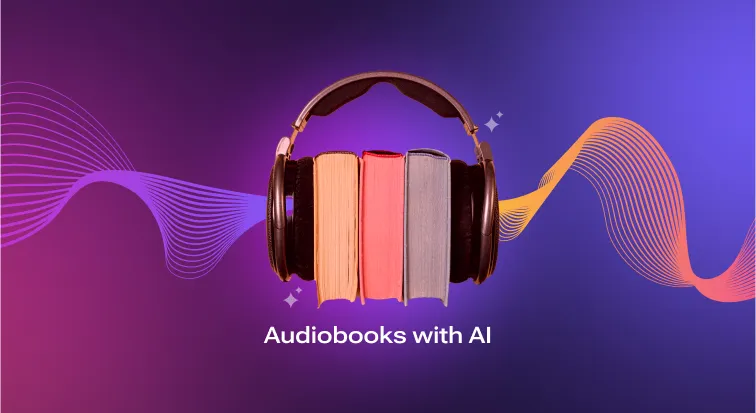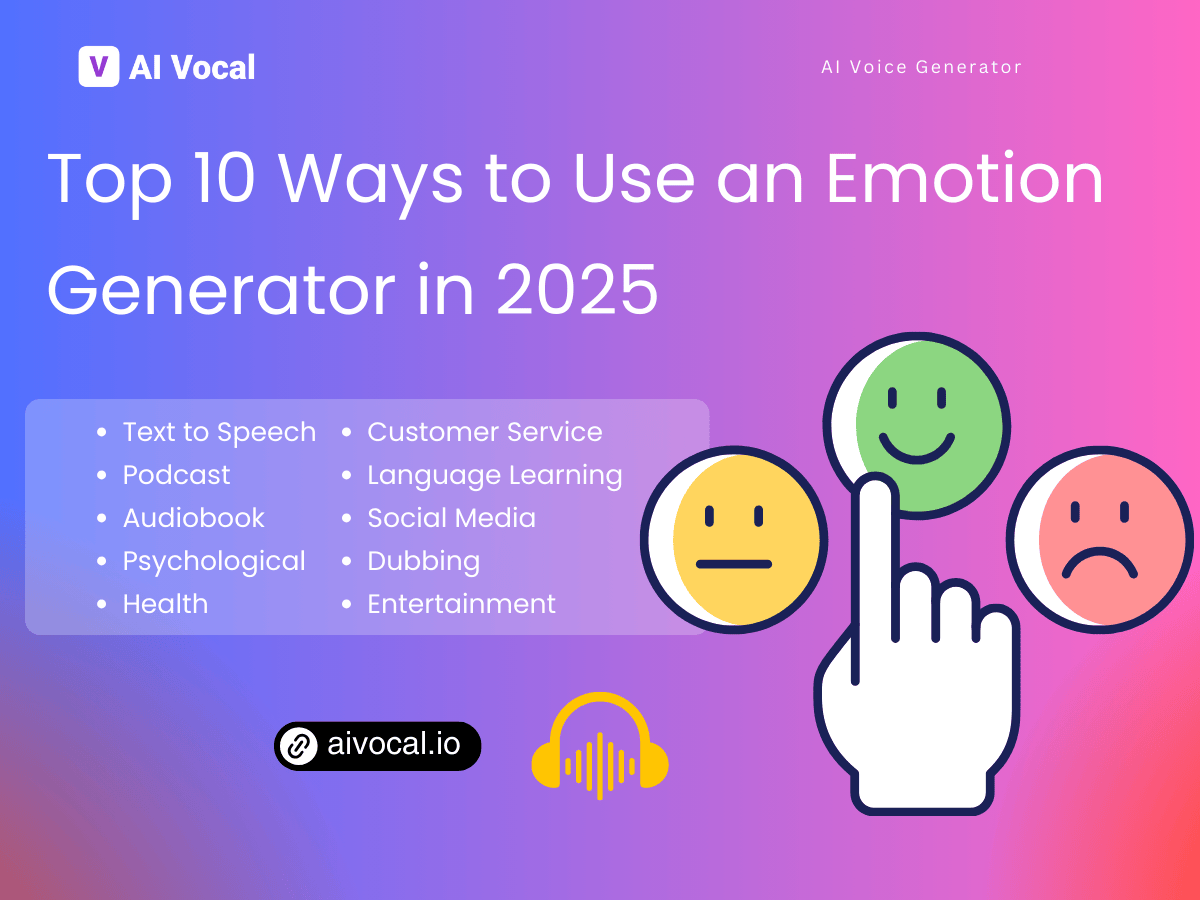Introduction to Emotion Generators and Their Applications in 2025
In 2025, with the rapid development of artificial intelligence, the emotion generator has evolved from a laboratory concept to a core tool for content creation. This technology accurately analyzes text semantics and dynamically generates matching voice emotions—such as joy, sadness, anger, and surprise—revolutionizing the human-computer interaction experience. This article will explore the groundbreaking applications of an emotion generator in ten areas to help you seize the benefits of this technology.
Top 10 Ways to Use an Emotion Generator in 2025
From AI voice synthesis to interactive storytelling, the emotion generator is becoming an essential tool for creators, developers, and educators in 2025. By simulating and enhancing emotional expression, it transforms digital voices, virtual characters, and multimedia experiences into something far more engaging and human-like. In this article, we’ll explore ten innovative ways you can leverage an emotion generator across different industries and creative projects.
Using an Emotion Generator to Enhance Human Voice in TTS

By 2025, TTS systems will incorporate emotion generators, effectively eliminating mechanical reading. They will automatically adjust intonation, speed, and emotional intensity based on the text, making e-books, navigation prompts, and customer service voices more expressive. For example, news broadcasts can adopt serious or uplifting emotions, children's story narrations can switch between cheerful and mysterious tones, and even simulate the voices of virtual characters of different ages and personalities, significantly enhancing user immersion and giving AI voices a truly human touch. With AIVocal AI Speech, you can access advanced TTS technology with rich emotional presets, allowing you to instantly transform plain text into lifelike speech that resonates with your audience.
Boosting Podcast Engagement with an Emotion Generator

Independent podcast creators can use the emotion generator to create multi-character interpretations or heightened emotions without the need for a professional voiceover team. This emotional AI tool can add a "nostalgic radio" quality to the host's original recordings or generate interactive dialogue with virtual guests, making a single-person program sound like a full team collaboration. Historical podcasts can even recreate the passion or sadness of ancient speeches, while talk shows can enhance humor through exaggerated intonation, significantly lowering the barrier to entry for producing high-quality audio content. With AI Podcast, podcasters can integrate emotion-driven AI voices, automate multi-role dialogues, and fine-tune delivery styles—without expensive studio time—making professional audio production accessible to everyone.
Character Emotion Simulation in Game Development

NPCs in open-world games use an emotion generator to achieve dynamic emotional feedback, adjusting their voices in real time based on player behavior. For example, an NPC might express disappointment after a mission failure or admiration after a battle victory. Wounded characters' voices are interspersed with painful gasps, while villains' lines take on a naturally sarcastic tone. This AI emotion system prevents repetition in numerous side conversations, providing a personalized audio experience tailored to the storyline and becoming a core tool for enhancing game immersion.
Storytelling and Writing Assistance Using an Emotion Generator

Children's interactive picture books use an emotion generator, allowing characters to respond to correct choices with surprised sounds, using encouraging tones to guide children's continued exploration. A suspense novel app can automatically adjust narration intensity based on the plot. Each user choice triggers a different emotional voice response from the character, transforming linear text into an immersive narrative. This voice emotion model is particularly suitable for educational content and works with branching plots, allowing listeners to move from passive listening to emotional participation.
Education and Acting Training Powered by an Emotion Generator
Meditation apps' guided voices convey a sense of tranquility through an emotion generator, while elderly companion robots share news in cheerful tones. AI psychological assistants no longer sound cold and aloof, displaying gentle empathy when offering comfort, firm conviction when encouraging, and even adapting their responses based on the user's emotional state. This humanized emotional synthesis significantly enhances credibility and brings technological care closer to the fundamental needs of human communication.
AI Virtual Hosts and Interactive Content Creation
Upon recognizing a user's angry tone, a bank's IVR system can switch to a gentle, soothing voice via an emotion generator. E-commerce assistants use enthusiastic voices to recommend products, while logistics notifications remain calm and clear. This AI-powered emotion rendering allows customer service bots to match emotions precisely in scenarios like apologies, answers, and sales pitches. It avoids escalating conflicts and builds brand affinity, becoming a hidden weapon for companies to improve customer satisfaction.
Enhancing Marketing and Branding Content
French learning apps simulate laid-back café conversations, while business English courses train students to negotiate with confidence. The emotion generator not only corrects pronunciation but also analyzes emotional flaws in learners' recordings, providing emotionally annotated demonstration readings. From casual small talk to impactful speeches, this emotion synthesis engine helps users break free from robotic intonation and truly master the emotional dimension of language.
Social Media and Short Video Creation
Luxury brand ads generate elegant and relaxed voiceovers, while promotional content uses urgency and excitement. The emotion generator supports A/B testing of emotional tones, and can customize rebellious or minimalist voices for niche brands. Compared with costly voiceover revisions, this AI emotion module can quickly iterate styles, ensuring a consistent voice image and brand identity, capturing user attention in fast-moving feeds.
Health and Mental Wellness Applications
Meditation guides can use an emotion generator to produce calming, soothing speech patterns for relaxation. Elderly care bots deliver daily updates in reassuring tones, while AI counselors offer compassionate responses during therapy sessions. This emotional AI tool bridges the gap between technology and empathy, making digital wellness interactions more comforting and effective.
Entertainment and Random Fun Uses
Electronic musicians incorporate AI-generated anxious vocal slices into tracks, while horror game sound designers create eerie, quivering atmospheres. The emotion generator transcends traditional sample libraries, synthesizing abstract emotional sounds—such as ethereal hums or distorted cheers—on demand. As a creative catalyst, this intelligent emotion module inspires new aural experiences in music production and interactive media.
Frequently Asked Questions about Emotion Generator
Q1: What is an emotion generator?
An emotion generator is an AI-powered tool that can simulate or apply different emotional tones to text, voice, or characters. It is widely used in TTS, podcasts, gaming, and storytelling to make content more engaging.
Q2: How does it work in TTS?
In TTS, the emotion generator analyzes text and applies emotional patterns—such as happiness, sadness, or excitement—by adjusting tone, pitch, and pacing to create more human-like speech.
Q3: Can I use it for podcasts?
Yes. Many podcasters use an emotion generator to add depth and authenticity to narration, interviews, or storytelling, making the listening experience more immersive.
Q4: Is it useful in game development?
Absolutely. Developers integrate an emotion generator to give NPCs realistic emotional responses, making in-game interactions more dynamic.
Q5: Are there free versions?
Yes, some online tools provide free emotion generator features, but professional-grade models offer more nuanced, high-quality results.
Q6: Will it replace voice actors?
Not entirely. While the emotion generator can produce highly realistic voices, human actors still bring subtle emotional nuances that AI cannot fully replicate.
Conclusion
In 2025, the emotion generator is no longer just a novelty—it has become a vital asset in creative and professional fields. From making TTS voices more human to enriching podcasts, enhancing game worlds, and supporting education and wellness, its applications are expanding rapidly. As AI evolves, emotion generators will deliver even greater precision, customization, and range, helping creators connect with audiences in authentic ways. Whether you’re a developer, content creator, educator, or innovator, now is the perfect time to integrate an emotion generator into your projects. The emotional future of AI content creation is here—don’t be left behind.


